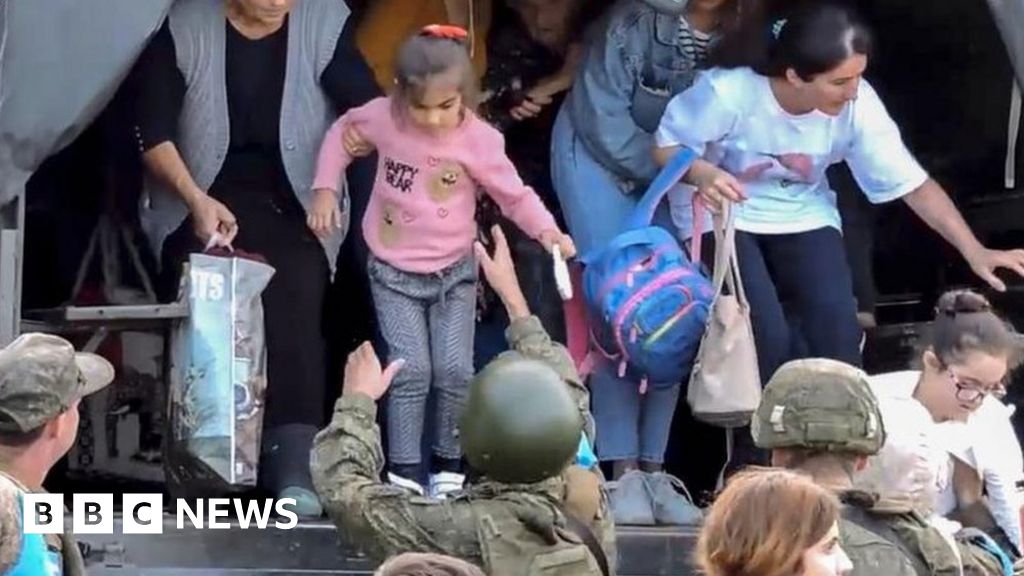image source, Russian Ministry of Defense
Russia said it had evacuated 2,000 Armenians from villages near the fighting
Azerbaijan’s president has declared his country’s sovereignty over Nagorno-Karabakh restored after a 24-hour military offensive against ethnic-Armenian forces.
Ilham Aliyev praised the bravery of Azerbaijan’s military hours after Karabakh forces agreed to surrender.
About 120,000 Armenians live in the South Caucasus region, which is internationally recognized as part of Azerbaijan.
Azerbaijan now wants to bring the breakaway region under full control.
Its military launched an “anti-terrorist” operation on Tuesday, demanding that Karabakh’s forces raise the white flag and disband their “illegal regime”. After a nine-month siege without the support of neighboring Armenia, the ethnic Armenians quickly conceded.
Armenian officials said at least 32 people, including seven civilians, were killed and another 200 wounded. However, according to a separatist Armenian human rights official, at least 200 people were killed and more than 400 injured. The BBC was unable to verify any of the figures.
On Wednesday evening, after a ceasefire was agreed, Armenian officials accused Azerbaijan of firing on troops near the town of Chodak on the border between the two countries, but Azerbaijan immediately denied the claims.
Beginning at 13:00 local time (09:00 GMT) on Wednesday, Azerbaijan’s military said it had captured more than 90 positions from the Armenians before both sides announced a complete cessation of hostilities by Russian peacekeepers.
Under the terms of the ceasefire outlined by Azerbaijan and Russia, peacekeepers on the ground must commit to the complete disbandment and disarmament of local Karabakh forces.
There is also a commitment to the withdrawal of Armenian forces, even though its government denies there is any military presence there.
Talks on “reunification issues” were held between Baku officials and Armenian representatives of Karabakh in Yevlag on Thursday morning.
President Aliyev said that Azerbaijanis have nothing against the people, only their “criminal junta”.
Yevlakh is about 100 km (60 mi) north of Khankendi, the regional capital of Karabakh, known as Stepanakert by Armenians.
image source, Artsakh Public TV
Local officials say 32 people died and 200 were injured in Karabakh
People rush to the airport
Marut Vanyan, a journalist in Karabakh, said many families spent Tuesday night in cellars: “I didn’t sleep, I didn’t eat. It’s quiet now, but it’s a strange feeling. For now, what do we have to do? Understand this bloodshed and what to do next.”
Russia said its peacekeepers had evacuated 5,000 troops from dangerous areas since the offensive began, according to the country’s Interfax news agency.
As the cease-fire was announced, Karabakh officials urged residents to stay in shelters and not to travel to the local airport near the Russian peacekeeping base. However, crowds soon gathered near the airport and it was unclear what support they would have as darkness fell hours later.
Thomas de Waal, Caucasus expert at Carnegie Europe, said the terms of the ceasefire and the upcoming negotiations left Azerbaijan’s terms and Armenians vulnerable.
“It looks like the end of a 35-year plan, some would say a century-old plan for the Karabakh Armenians to secede from Azerbaijan,” he told the BBC.
“Probably, unfortunately, we see a plan in which the Azerbaijanis offer very little to the Karabakh Armenians, otherwise they would not all leave.”
Armenian Prime Minister Nikol Pashinyan made it clear that his government was not involved in the ceasefire talks and demanded that Russian peacekeepers take full responsibility for the safety of the local population. On Tuesday he accused Azerbaijan of “ethnic cleansing” in Karabakh.
Azerbaijan’s presidential envoy Elzin Amirbekov told the BBC that Russian peacekeepers helped facilitate the ceasefire: “I think they should be counted on for the implementation part.”
The ongoing crisis
Since the collapse of the Soviet Union, Armenia and its neighbors have fought two wars over Nagorno-Karabakh, a mountainous, landlocked region southwest of Azerbaijan.
A six-week war in 2020 led to several thousand deaths, but Turkey’s support helped Azerbaijan retake territory surrounding and within the enclave, isolating ethnic Armenians.
For the past nine months, Azerbaijan has maintained an effective blockade of the only route from Armenia to Karabakh, known as the Lachin Corridor. Ethnic Armenians in the enclave complained of lack of food, medicine and toilets and Armenia was unable to help.
Some 2,000 Russian peacekeepers are supposed to monitor the 2020 ceasefire, but Moscow’s interest in Armenia has waned during the war in Ukraine, although Armenia is part of Russia’s CSTO military alliance.
Last May, the Armenian prime minister reportedly said he was willing to recognize Karabakh as part of Azerbaijan in exchange for the protection of the ethnic Armenian population.
“Azerbaijan’s 86,600 sq km area includes Nagorno-Karabakh,” Mr Pashinyan was quoted as saying, referring to Azerbaijan as a whole.
Russia is also irritated by Mr Pashinyan’s apparent pivot to the West.
Earlier this month his wife, Anna Hagobyan, shook hands with Ukraine’s president at a conference in Kyiv, where dozens of Armenian and American soldiers participated in military exercises together this week.
The Kremlin has denied Armenian accusations that it is not doing enough to help its ally.
President Vladimir Putin said last week that Russia had no problem with Armenia’s prime minister, but added: “If Armenia recognizes that Karabakh is part of Azerbaijan, what should we do?”
Hundreds of protesters in Yerevan called on the prime minister to resign on Tuesday over his handling of the crisis and he warned that unidentified forces were calling for a coup.

